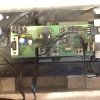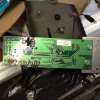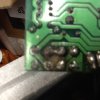The mechanic
Registered
Hello everyone,
I have an LGB 20670 (yellow) track cleaner. Recently it has stopped working and "shorts" across the track. I am supplying 20v and it is drawing in excess of 4.5amps! (I have a current-limiting power supply and deemed this to be sufficient to "prove" a short without "over-cooking the loco!" Note, the "short" exists no-matter what position the internal selector switch is set to.
I have removed both the drive wheel unit and the cleaning wheel unit and tested them. Both function normally on around 14v. Drawing much less than 4.5amps!
This lead me to suspect the control board. When I removed the housings, I found that one of the four black components (diodes?) to the corner of the circuit board, had become detached from the board and there was a noticeable burning of that corner of the board. I suspect that the back side had come into contact with the metal loco weight and arcing had been occurring. I have soldered the loose component but the "short" is still there. - there doesn't look to be any other noticeable visible damage to the board see photos below...
Does anyone have any experience of remedying this issue? Is it something that can be done easily? Are reconditioned boards available in the UK and from where?
I am asking this as I am running out of ideas as to a remedy.
Hope someone can help me?
Thanks
Dave
I have an LGB 20670 (yellow) track cleaner. Recently it has stopped working and "shorts" across the track. I am supplying 20v and it is drawing in excess of 4.5amps! (I have a current-limiting power supply and deemed this to be sufficient to "prove" a short without "over-cooking the loco!" Note, the "short" exists no-matter what position the internal selector switch is set to.
I have removed both the drive wheel unit and the cleaning wheel unit and tested them. Both function normally on around 14v. Drawing much less than 4.5amps!
This lead me to suspect the control board. When I removed the housings, I found that one of the four black components (diodes?) to the corner of the circuit board, had become detached from the board and there was a noticeable burning of that corner of the board. I suspect that the back side had come into contact with the metal loco weight and arcing had been occurring. I have soldered the loose component but the "short" is still there. - there doesn't look to be any other noticeable visible damage to the board see photos below...
Does anyone have any experience of remedying this issue? Is it something that can be done easily? Are reconditioned boards available in the UK and from where?
I am asking this as I am running out of ideas as to a remedy.
Hope someone can help me?
Thanks
Dave







